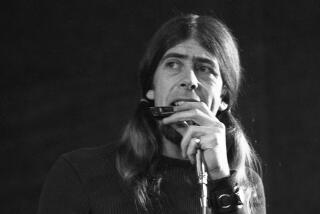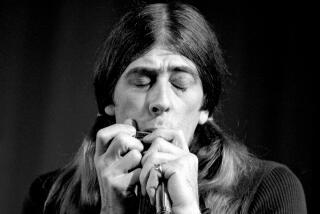Mingus at His Creative Best
- Share via
CHARLES MINGUS
“Passions of a Man: The Complete Atlantic Recordings (1956-1961)”
Rhino
* * * *
Bassist-composer Charles Mingus, by almost any evaluation, was one of the most important, innovative artists in the history of jazz, and also one of its most unpredictable.
In his early years, he moved through a variety of big band and small group settings--from outings with Lionel Hampton and Duke Ellington to rhythm and blues recordings (in which he was billed as Baron Von Mingus) to gigs with the Red Norvo trio, Stan Getz, Art Tatum, Bud Powell and others. His irascible, sometimes violent temper--always an element in Mingus’ dealings with others--eventually led to a parting of the ways with Ellington, and more than a few musicians can tell tales of unhappy encounters with the bassist.
In his later years, his occasionally excellent work was frequently offset by confusing live performances and qualitatively erratic recording efforts.
But in the decade between the mid-’50s and the mid-’60s, Mingus’ creative vision was at its fullest, both in terms of its expansive perspective and in terms of its penetrating musical focus. And the six Atlantic recordings included in this six-CD boxed set--”Pithecanthropus Erectus,” “The Clown,” “Blues and Roots,” “Oh Yeah,” “Tonight at Noon” and “Mingus at Antibes”--are among his finest achievements. The set includes, in addition, four tracks from a 1956 session with vibraphonist Teddy Charles, “Word From Bird,” and previously unissued alternate takes on several Mingus compositions.
“Pithecanthropus Erectus,” performed by a band that includes alto saxophonist Jackie McLean and pianist Mal Waldron, is a breakthrough for Mingus, proof of his ability to create jazz that was structured and cohesive. “The Clown” includes his “Haitian Fight Song,” “Reincarnation of a Lovebird” and, in a typically offbeat number, the addition of monologuist Jean Shepherd for a verbal improvisation on the title track.
“Blues and Roots” features one of Mingus’ most attractive ensembles--including saxophonists McLean, John Handy, Booker Ervin and Pepper Adams, and trombonists Jimmy Knepper and Willie Dennis--performing “E’s Flat Ah’s Flat Too” (Mingus’ imaginativeness extended to his titling, as well) and “Wednesday Night Prayer Meeting.”
The encounter between Mingus (playing piano) and eclectic saxophonist Rahsaan Roland Kirk on “Oh Yeah” is the stuff of jazz legend, and the live concert material from “Mingus at Antibes” affords a tantalizing taste of Mingus’ work with the gifted, and still too little acknowledged woodwind player, Eric Dolphy.
As good as this collection is, however, it’s worth noting that it represents only the tip of the extraordinary surge of creativity Mingus experienced during this period. Among the numerous other classics he produced between 1955 and 1965--all equally significant--were “New Tijuana Moods” for RCA in 1957; “East Coasting” for Bethlehem, also in 1957; “Mingus Ah Um” and “Mingus Dynasty” for Columbia in 1959; a series of albums for Candid in 1960; and “The Black Saint and the Sinner Lady” for Impulse! in 1963.
It’s a remarkable string of accomplishments, and evidence that Mingus belongs on the short list of legendary, influential jazz composers that includes Duke Ellington, Billy Strayhorn, Fletcher Henderson and Thelonious Monk.
*
Albums are rated on a scale of one star (poor) to four stars (excellent).
More to Read
The biggest entertainment stories
Get our big stories about Hollywood, film, television, music, arts, culture and more right in your inbox as soon as they publish.
You may occasionally receive promotional content from the Los Angeles Times.










